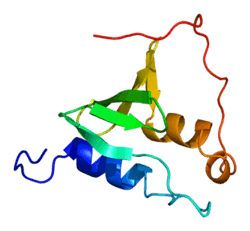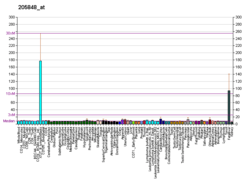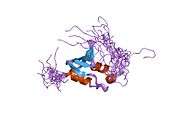GAS2
Growth arrest-specific protein 2 is a protein that in humans is encoded by the GAS2 gene.[5][6]
The protein encoded by this gene is a caspase-3 substrate that plays a role in regulating microfilament and cell shape changes during apoptosis. It can also modulate cell susceptibility to p53-dependent apoptosis by inhibiting calpain activity. Two alternatively spliced transcript variants encoding the same protein have been described for this gene.[6]
References
- 1 2 3 GRCh38: Ensembl release 89: ENSG00000148935 - Ensembl, May 2017
- 1 2 3 GRCm38: Ensembl release 89: ENSMUSG00000030498 - Ensembl, May 2017
- ↑ "Human PubMed Reference:".
- ↑ "Mouse PubMed Reference:".
- ↑ Collavin L, Buzzai M, Saccone S, Bernard L, Federico C, DellaValle G, Brancolini C, Schneider C (Jun 1998). "cDNA characterization and chromosome mapping of the human GAS2 gene". Genomics. 48 (2): 265–9. doi:10.1006/geno.1997.5172. PMID 9521882.
- 1 2 "Entrez Gene: GAS2 growth arrest-specific 2".
Further reading
- Olson RE, Morello JA, Kieff ED (1975). "Antibiotic treatment of oral anaerobic infections". Journal of Oral Surgery. 33 (8): 619–21. PMID 1056466.
- Brancolini C, Bottega S, Schneider C (1992). "Gas2, a growth arrest-specific protein, is a component of the microfilament network system". J. Cell Biol. 117 (6): 1251–61. doi:10.1083/jcb.117.6.1251. PMC 2289493. PMID 1607387.
- Schneider C, King RM, Philipson L (1988). "Genes specifically expressed at growth arrest of mammalian cells". Cell. 54 (6): 787–93. doi:10.1016/S0092-8674(88)91065-3. PMID 3409319.
- Sgorbissa A, Benetti R, Marzinotto S, et al. (2000). "Caspase-3 and caspase-7 but not caspase-6 cleave Gas2 in vitro: implications for microfilament reorganization during apoptosis". J. Cell Sci. 112 (23): 4475–82. PMID 10564664.
- Benetti R, Del Sal G, Monte M, et al. (2001). "The death substrate Gas2 binds m-calpain and increases susceptibility to p53-dependent apoptosis". EMBO J. 20 (11): 2702–14. doi:10.1093/emboj/20.11.2702. PMC 125501. PMID 11387205.
- Strausberg RL, Feingold EA, Grouse LH, et al. (2003). "Generation and initial analysis of more than 15,000 full-length human and mouse cDNA sequences". Proc. Natl. Acad. Sci. U.S.A. 99 (26): 16899–903. doi:10.1073/pnas.242603899. PMC 139241. PMID 12477932.
- Tsutsumi S, Kamata N, Vokes TJ, et al. (2004). "The novel gene encoding a putative transmembrane protein is mutated in gnathodiaphyseal dysplasia (GDD)". Am. J. Hum. Genet. 74 (6): 1255–61. doi:10.1086/421527. PMC 1182089. PMID 15124103.
- Gerhard DS, Wagner L, Feingold EA, et al. (2004). "The status, quality, and expansion of the NIH full-length cDNA project: the Mammalian Gene Collection (MGC)". Genome Res. 14 (10B): 2121–7. doi:10.1101/gr.2596504. PMC 528928. PMID 15489334.
- Benetti R, Copetti T, Dell'Orso S, et al. (2005). "The calpain system is involved in the constitutive regulation of beta-catenin signaling functions". J. Biol. Chem. 280 (23): 22070–80. doi:10.1074/jbc.M501810200. PMID 15817486.
This article is issued from
Wikipedia.
The text is licensed under Creative Commons - Attribution - Sharealike.
Additional terms may apply for the media files.






